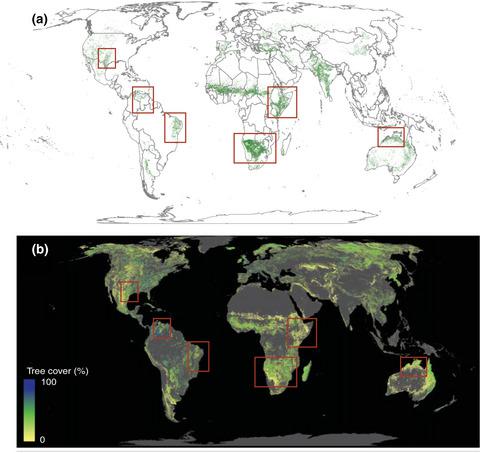当前位置:
X-MOL 学术
›
Glob. Change Biol.
›
论文详情
Our official English website, www.x-mol.net, welcomes your
feedback! (Note: you will need to create a separate account there.)
A lesson unlearned? Underestimating tree cover in drylands biases global restoration maps.
Global Change Biology ( IF 10.8 ) Pub Date : 2020-07-02 , DOI: 10.1111/gcb.15187 M E Fagan 1
Global Change Biology ( IF 10.8 ) Pub Date : 2020-07-02 , DOI: 10.1111/gcb.15187 M E Fagan 1
Affiliation

|
Two recent global maps of tree restoration potential have identified vast regions where tree cover could be increased, ranging from 0.9 to 2.3 billion hectares. Both maps, however, emphasized dryland regions, with arid biomes making up 36%–42% of potential restoration area. Dryland biomes have repeatedly been recognized as inappropriate regions for expanding tree cover due to the risks of biodiversity loss, water overconsumption, and fire, so maps that highlight these regions for restoration must sustain careful scrutiny. Here, I show that both recent attempts to map restoration potential in arid regions have been hindered by underlying errors in the global tree cover maps they used. Systematic underestimates of existing sparse tree cover led directly to large overestimates of the potential for tree recovery in drylands. The Atlas of Forest Landscape Restoration Opportunities (Laestadius et al., Unasylva , 2011, 62 , 47) overestimated tree restoration potential across a third of arid biomes by between 7% and 20% (55–166 million hectares [Mha]). Similarly, Bastin, Finegold, Garcia, Mollicone, et al. (Science, 2019, 365, 76 ) overestimated tree restoration potential across all arid biomes by 33%–45% (316–440 Mha). These inaccuracies limit the utility of this research for policy decisions in drylands and overstate the potential for tree planting to address climate change. Given this long‐standing but underappreciated challenge in mapping global tree cover, I propose various ways forward that keep this lesson in mind. To better monitor and restore tree cover, I call for re‐interpretation and correction of existing global maps, and for a new focus on quantifying sparse tree cover in drylands and other systems.
中文翻译:

一堂没学到的课?干旱地区的树木覆盖率低估了全球恢复地图的偏差。
最近的两张全球树木恢复潜力全球地图已经确定了可以增加树木覆盖的广阔区域,范围从0.9到23亿公顷。然而,两张地图都强调干旱地区,干旱的生物群落占潜在恢复面积的36%至42%。由于生物多样性丧失,水资源过度消耗和火灾的风险,旱地生物群落被反复认为是不适合扩大树木覆盖的区域,因此突出显示这些区域以进行恢复的地图必须经过仔细的审查。在这里,我表明,最近两次尝试在干旱地区绘制恢复潜力的尝试都受到了所使用的全局树覆盖图潜在错误的阻碍。对现有稀疏树木覆盖率的系统低估直接导致对旱地树木恢复潜力的高估。林业杂志,2011年,62横跨干旱生物群落的第三7%和20%之间,47)高估树恢复电势(55-166万公顷[百万公顷])。类似地,Bastin,Finegold,Garcia,Mollicone等。(科学,2019,365,76)将所有干旱生物群落的树木恢复潜力高估了33%–45%(316–440 Mha)。这些不准确之处限制了这项研究在旱地政策决策中的应用,并夸大了植树解决气候变化的潜力。鉴于在绘制全局树的覆盖图方面这一长期但未得到充分认识的挑战,我提出了多种方法来牢记这一课。为了更好地监视和恢复树木的覆盖率,我呼吁对现有的全球地图进行重新解释和校正,并着重于量化旱地和其他系统中稀疏的树木覆盖率。
更新日期:2020-08-11
中文翻译:

一堂没学到的课?干旱地区的树木覆盖率低估了全球恢复地图的偏差。
最近的两张全球树木恢复潜力全球地图已经确定了可以增加树木覆盖的广阔区域,范围从0.9到23亿公顷。然而,两张地图都强调干旱地区,干旱的生物群落占潜在恢复面积的36%至42%。由于生物多样性丧失,水资源过度消耗和火灾的风险,旱地生物群落被反复认为是不适合扩大树木覆盖的区域,因此突出显示这些区域以进行恢复的地图必须经过仔细的审查。在这里,我表明,最近两次尝试在干旱地区绘制恢复潜力的尝试都受到了所使用的全局树覆盖图潜在错误的阻碍。对现有稀疏树木覆盖率的系统低估直接导致对旱地树木恢复潜力的高估。林业杂志,2011年,62横跨干旱生物群落的第三7%和20%之间,47)高估树恢复电势(55-166万公顷[百万公顷])。类似地,Bastin,Finegold,Garcia,Mollicone等。(科学,2019,365,76)将所有干旱生物群落的树木恢复潜力高估了33%–45%(316–440 Mha)。这些不准确之处限制了这项研究在旱地政策决策中的应用,并夸大了植树解决气候变化的潜力。鉴于在绘制全局树的覆盖图方面这一长期但未得到充分认识的挑战,我提出了多种方法来牢记这一课。为了更好地监视和恢复树木的覆盖率,我呼吁对现有的全球地图进行重新解释和校正,并着重于量化旱地和其他系统中稀疏的树木覆盖率。











































 京公网安备 11010802027423号
京公网安备 11010802027423号